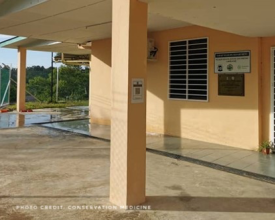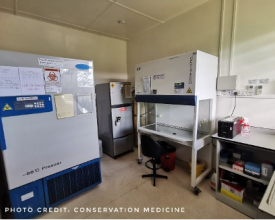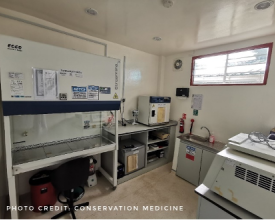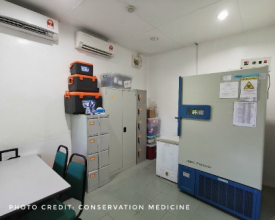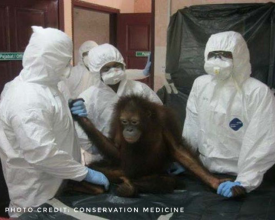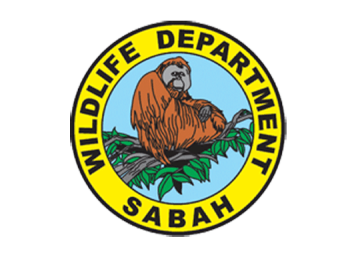
Sabah Wildlife Department’s Wildlife Health, Genetic and Forensic Laboratory – Design and Development
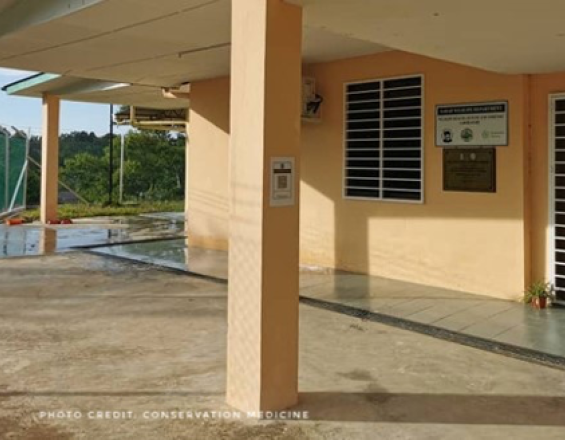
The PREDICT project, a global pathogen surveillance program, started in the state of Sabah in 2012 as a collaboration between Sabah Wildlife Department (SWD), Conservation Medicine (CM) and EcoHealth Alliance (EHA). Sabah Wildlife Department’s - Wildlife Health, Genetic and Forensic Laboratory (WHGFL) is a Biosafety Level 2 laboratory that was built in Sabah to avoid sending thousands of samples collected through PREDICT and ongoing projects out of the state for pathogen screenings. CM designed and oversaw the building of this laboratory certified since 2013 to international standards and are part of the management committee. The lab is used to screen samples for zoonotic disease, as well as genetic and forensic research. 65 novel and 18 known viruses were detected in Sabah through the PREDICT project, providing the Malaysian government with actionable data to inform risk mitigation policies at the national and state level.
Context
Challenges addressed
Shipping samples to Peninsular Malaysia or out of country for virus screening creates a biosafety and biosecurity risk, does not help develop local capacity and is too time, energy, and cost-intensive to be sustainable. To address this gap in capacity in Sabah, an existing empty building was identified and renovated to create a Biosafety Level 2 laboratory certifiable to international standards. This meant wildlife samples collected through the PREDICT and subsequent projects could be safely and quickly screened for zoonotic viruses. The creation of the lab has also allowed SWD to combat wildlife poaching and smuggling more effectively. Previously, samples were sent to Peninsular Malaysia and results were often delayed leading to suspects being released from custody and disappearing. With the WHGFL, SWD and DGFC can process forensic samples as soon as they are received which will lead to an increase in prosecutions. This capacity will be further enhanced once the WHGFL achieves ISO 17025 accreditation.
Location
Process
Summary of the process
The solution demonstrates how Partnerships and Collaboration can facilitate effective and efficient use of existing resources, as seen in the Utilizing Existing Infrastructure building block. These also show how collaboration can serve multiple objectives under the same roof, including to help address wildlife trafficking as well as wildlife and human health. The development and continued capacity expansion of the WHGFL reinforces the importance and utility of local access and local ownership of technology to serve both local and global priorities.
Building Blocks
Utilizing Existing Infrastructure
When the PREDICT project began working in Sabah there was no laboratory dedicated to wildlife sample testing that met the necessary standards for biosafety. The financial and logistical hurdles of building the necessary infrastructure from the ground up were too high for this project, making a brand-new lab not an option. Instead, SWD and CM identified an existing empty building belonging to SWD in Sabah and renovated it to meet international laboratory standards, as detailed in the Biosafety in Microbiological and Biomedical Laboratories Guidelines (6th Ed.) for Biosafety Containment Level 2 requirements, to establish the WHGFL. These upgrades saved the project time and money, allowing samples to safely remain in Sabah for virus screening and creating a state-of-the-art lab for SWD and DGFC to pursue genetic and forensic research.
Enabling factors
While the existence of current physical infrastructure that can be built upon is the most important factor, support from the Sabah state government, Sabah Wildlife Department and Dr Stuart D. Blacksell from MORU enabled the necessary changes to be carried out.
Lesson learned
As vital as a biosafe and bio-secured laboratory is for any area aiming to do disease screenings, most locations do not have the space, capacity, or resources to build the required infrastructure from the ground up. While facing this logistical and financial challenge, the project team found innovative solutions using the resources currently available in-country and low-cost sustainable solutions to create this state-of the art facility. When designing a laboratory, it is important to consider exactly what samples, activities and processes will be conducted in the lab, conduct a full risk, and gap assessment and design a facility to manage these risks and hazards tailored to your specific needs.
Partnerships & Collaboration
From the conception of the PREDICT project through to today’s day-to-day laboratory management, partners working effectively across sectors has been an essential building block. The PREDICT project brought conservation and health nonprofits and Malaysian federal and local government departments together to collaborate on zoonotic disease surveillance. Over the last 10 years the WHGFL has been able to expand into new surveillance, genetic, and forensic research as capacity is built through open and productive collaboration. The Sabah Wildlife Department has scaled up their involvement increasing their funding for the WHGFL each year and leading the management committee. The management committee ensures the multiple projects utilizing the small laboratory are coordinated and organized, especially as new projects come on board and the scope of work expands.
Enabling factors
A One Health approach was employed at every step, ensuring priorities of different sectors were heard and respected. Siloed sectors were brought together to meet a shared goal of conservation through zoonotic disease screenings that promoted human and wildlife health. By highlighting the interconnection of human, animal, and environmental health, collaboration, instead of competition, was emphasized and promoted. Wildlife disease screening results provided Sabah State Health Department with actionable data to inform risk mitigation policies at the state level.
Lesson learned
Multiple partners were involved with the renovation of an empty building to create a laboratory meeting international biosafety and biosecurity standards, and while the initial investment was from outside sources, in recent years local leadership has taken on a larger role in management. The success of the PREDICT project demonstrated the importance of the laboratory to local and global research efforts, earning a larger investment, both financial and bandwidth-wise, from local leaders. This has allowed budding partnerships to further develop and deepen over time.
Impacts
As the first certified BSL-2 biocontainment laboratory in Southeast Asia certified to international standards specifically for wildlife work, the WHGFL is a great example of how, with limited expense on construction and a sustainable annual maintenance budget, a state-of-the-art biosafe and bio-secure facility can be established and maintained for wildlife work. The WHGFL allows SWD to rapidly assess wildlife health prior to relocation, to engage in comprehensive disease screening efforts with partners like CM and EHA and conduct important genetic and forensic screenings and research. CM have been coordinating health checks and disease screenings with SWD, Sepilok Orangutan Rehabilitation Centre (SORC) and Bornean Sun Bear Conservation Centre (BSBCC) for endangered orangutans, gibbons, sun bears, and Bornean elephants held in captivity and in the wild. To date six novel and six known viruses from three local endangered species have been identified. These results are essential for SWD to make decisions on the further actions required to manage and conserve these important animals. CM is working closely with SWD and Danau Girang Field Centre (DGFC) to obtain ISO 17025 accreditation for the laboratory. Achieving this accrediatation will allow SWD to start using the laboratory to process forensic samples for prosecutions to help in its efforts to battle the illegal wildlife trade and poaching.
Beneficiaries
Sabah Wildlife Department
Sabah State Health Department
Local researchers
Laboratory staff
Wildlife
Humans
Sustainable Development Goals
Story
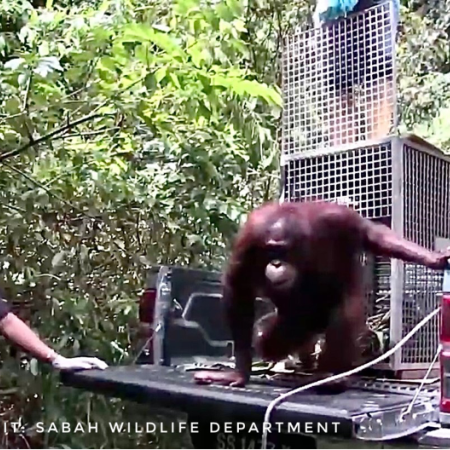
CM and EHA have been working in Malaysia for over 15 years. We encourage government and industry stakeholders to take One Health into account as they consider sustainable development and training local scientists on wildlife sampling and cutting-edge lab techniques. On Borneo, we have forged invaluable partnerships with other organizations working tirelessly to maintain the area’s unique biodiversity.
One of those is SWD, who in 1964, created SORC near Sandakan, Sabah for the purpose of rescuing and rehabilitating the critically endangered Bornean orangutans (Pongo pygmaeus morio) displaced by human development. Since opening, SORC has rescued and rehabilitated hundreds of orangutans around Sabah, mostly injured or orphaned.
But not all rescued orangutans are so lucky. Three of them – Tiger, Rosalinda, and Yoda – were diagnosed with Hepatitis B upon their entry to the SORC. At the time, the only testing available to Sabah Wildlife Department was a serological assay that could not determine which strain of Hepatitis B the animals had. Since one strain of Hepatitis B can be lethal to humans, SORC had no choice but to quarantine all three animals to avoid transmission of the disease to other orangutans and human visitors at the SORC.
During an annual screening of the SORC orangutans, the team from CM and the SWD Wildlife Health Unit with EHA support, collected samples from the three quarantined animals and testing of those samples using published hepatitis PCR protocols was done at the WHGFL. Sequencing analysis showed that the three orangutans had Orangutan Hepatitis B, which is endemic to wild orangutans and poses no public health concern. With this question answered, Tiger, Rosalinda, and Yoda could be released into their newly built rehabilitation pen: out of quarantine and able to play on the ground and enjoy the sunshine for the first time since their rescue. This story comes to a happy end for Rosalinda in 2016 and Tiger in 2017, who were subsequently released into the wild deep into the Tabin Wildlife Reserve in Lahad Datu, a mature secondary jungle and virgin primary forest covering nearly 300,000 acres.
